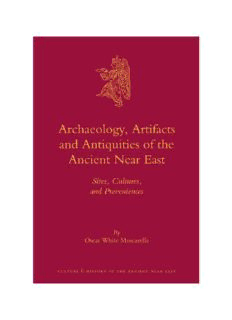
Archaeology, Artifacts and Antiquities of the Ancient Near East : Sites, Cultures, and Proveniences PDF
Preview Archaeology, Artifacts and Antiquities of the Ancient Near East : Sites, Cultures, and Proveniences
Archaeology, Artifacts and Antiquities of the Ancient Near East Culture and History of the Ancient Near East FoundingEditor M.H.E.Weippert Editor-in-Chief ThomasSchneider Editors EckartFrahm(YaleUniversity) W.RandallGarr(UniversityofCalifornia,SantaBarbara) B.Halpern(PennsylvaniaStateUniversity) TheoP.J.vandenHout(OrientalInstitute) IreneJ.Winter(HarvardUniversity) VOLUME62 Thetitlespublishedinthisseriesarelistedatbrill.com/chan Archaeology, Artifacts and Antiquities of the Ancient Near East Sites, Cultures, and Proveniences By OscarWhiteMuscarella LEIDEN•BOSTON 2013 LibraryofCongressCataloging-in-PublicationData Muscarella,OscarWhite. Archaeology,artifactsandantiquitiesoftheancientNearEast:sites,cultures,andproveniences/ byOscarWhiteMuscarella. p.cm. ISBN978-90-04-23666-0(hardback:alk.paper)–ISBN978-90-04-23669-1(e-book)1.Middle East–Antiquities.2.Excavations(Archaeology)–MiddleEast.3.MiddleEast–Civilization–To622.4. Iran–Antiquities.5.Excavations(Archaeology)–Iran.6.Turkey–Antiquities.7.Excavations (Archaeology)–Turkey–Gordion(Extinctcity)8.Forgeryofantiquities.I.Title. DS56.M8482013 939.4–dc23 2013006440 Thispublicationhasbeentypesetinthemultilingual“Brill”typeface.Withover5,100 characterscoveringLatin,IPA,Greek,andCyrillic,thistypefaceisespeciallysuitablefor useinthehumanities.Formoreinformation,pleaseseewww.brill.com/brill-typeface. ISSN1566-2055 ISBN978-90-04-23666-0(hardback) ISBN978-90-04-23669-1(e-book) Copyright2013byKoninklijkeBrillNV,Leiden,TheNetherlands. KoninklijkeBrillNVincorporatestheimprintsBrill,GlobalOriental,HoteiPublishing, IDCPublishersandMartinusNijhoffPublishers. Allrightsreserved.Nopartofthispublicationmaybereproduced,translated,storedin aretrievalsystem,ortransmittedinanyformorbyanymeans,electronic,mechanical, photocopying,recordingorotherwise,withoutpriorwrittenpermissionfromthepublisher. AuthorizationtophotocopyitemsforinternalorpersonaluseisgrantedbyKoninklijkeBrillNV providedthattheappropriatefeesarepaiddirectlytoTheCopyrightClearanceCenter, 222RosewoodDrive,Suite910,Danvers,MA01923,USA. Feesaresubjecttochange. Thisbookisprintedonacid-freepaper. CONTENTS Introduction............................................................ 1 PARTONE SITESANDEXCAVATIONS SectionOne.Iran 1. TheTumuliatSéGirdan:APreliminaryReport .................... 9 2. TheTumuliatSéGirdan:SecondReport........................... 43 3. TheChronologyandCultureofSéGirdan:PhaseIII ............... 83 4. Qalatgah:AnUrartianSiteinNorthwesternIran................... 97 5. ExcavationsatAgrabTepe,Iran .................................... 109 6. TheIronAgeatDinkhaTepe,Iran.................................. 161 7. WarfareatHasanluintheLate9thCenturybc..................... 255 8. TheHasanluLionPinsAgain....................................... 285 9. TheExcavationofHasanlu:AnArchaeologicalEvaluation......... 305 10. TheIranianIronIIIChronologyatMuweilahintheEmirateof Sharjah ............................................................. 351 11. TheLocationofUlhuandUisˇeinSargonII’sEighthCampaign, 714bc............................................................... 369 12. SurkhDumatTheMetropolitanMuseumofArt:AMini-Report... 389 13. North-WesternIran:BronzeAgetoIronAge ....................... 459 14. Jiroftand“Jiroft-Aratta”:AReviewArticleofYousefMadjidzadeh, Jiroft:TheEarliestOrientalCivilization.............................. 485 15. SargonII’s8thCampaign:AnIntroductionandOverview.......... 523 SectionTwo.Anatolia 16. KingMidas’TumulusatGordion................................... 533 17. TheIronAgeBackgroundtotheFormationofthePhrygianState.. 549 18. TheDateoftheDestructionoftheEarlyPhrygianPeriodat Gordion ............................................................ 569 19. AgainGordion’sEarlyPhrygianDestructionDate:ca.700+/-bc... 601 20. UrartianMetalArtifacts:AnArchaeologicalReview ............... 621 vi contents PARTTWO ARTIFACTS,CULTURES,FORGERIES,ANDPROVENIENCE SectionOne.TheAegeanandtheAncientNearEast 21. TheArchaeologicalEvidenceforRelationsbetweenGreeceand IranintheFirstMillenniumbc..................................... 655 22. UrartianBellsandSamos........................................... 689 23. KingMidasofPhrygiaandtheGreeks.............................. 703 24. GreekandOrientalCauldronAttachments:AReview ............. 725 SectionTwo.Artifacts 25. FibulaeRepresentedonSculpture.................................. 767 26. PhrygianorLydian? ................................................ 783 27. FibulaeandChronology,MarlikandAssur......................... 803 28. ParasolsintheAncientNearEast .................................. 817 SectionThree.TheAntiquitiesMarketandthePlunderCulture 29. ThePopeandtheBitterFanatic .................................... 827 30. TheAntiquitiesTradeandtheDestructionofAncientNear EasternCultures.................................................... 837 31. TheFifthColumnwithintheArchaeologicalRealm:TheGreat Divide .............................................................. 861 SectionFour.Forgeries 32. BazaarArchaeology ................................................ 879 33. ExcavatedintheBazaar:Ashurbanipal’sBeaker.................... 889 34. VonBissing’sMemphisStela:AProductofCulturalTransfer? ...... 901 35. GudeaornotGudeainNewYorkandDetroit:Ancientor Modern?............................................................ 915 36. TheVeracityof“Scientific”TestingbyConservators................ 931 SectionFive.ForgeriesofArchaeologicalProvenience 37. “Ziwiye”andZiwiye:TheForgeryofaProvenience................. 955 38. MedianArtandMedizingScholarship ............................. 999 39. MuseumConstructionsoftheOxusTreasures:Forgeriesof ProvenienceandAncientCulture ..................................1025 40. ExcavatedandUnexcavatedAchaemenianArt.....................1043 INTRODUCTION When asked by Jennifer Pavelko of Brill USA to compile a volume of my pastarticles,onthemodelofthetwovolumesofIreneWinter’soutstand- ingscholarshippublishedbyBrill,Iwasofcourseflattered.Andthenbegan thedifficulttaskofdecisionmaking.Giventhelimitationofapproximately forty articles to be selected by me, I had first to examine my curriculum vitaandmakealistofwhichtochoose.WhenIreachedfiftyarticlesIwas obliged to refocus my mind and eliminate ten of them. This exercise was fortunate,Ibelieve,foritforcedmenotmerelytofocusonworksthattomy mindreflectadiachroniccompendiumofmydecadesofwriting,butcon- comitantly,andasobjectivelyaspossible,tocontemplatetheverynature andthrustsofmyworkasawhole.Thescopeofmyresearchandwriting haswidenedfromthe“pure”archaeologicalworkofexcavationreportsand artifactanalysestoincludeasharpenedinterestinthevastnumberofunex- cavatedantiquities—and,asIcametorealize,offorgeries—aswellasasso- ciatedculturalphenomenathatoftenruncontrarytoarchaeologicalgoals. InthisintroductionIpresentmyacademicandintellectualbackgroundasa wayofexplaininghowmyinterestsmultipliedanddeveloped.Ivigorously insist that although to some the subjects of artifact analysis, forgery, and provenancemightappeartobediverse,theyaretothecontrarynotdiscrete subsetsofarchaeologicaldiscourse;theycollectivelyformequalcomponents ofthecoreofarchaeologicalresearchandconclusion-formation. I readily identify myself as an archaeologist, one concerned with the materialandhistoricalculturesoftheancientNearEast,primarilythoseof ancient Iran and Anatolia; I do not further identify myself as a specialist, suchasananthropologistorarthistorian,inasmuchasIseetheiractivities asinherentinarchaeologicalresearch.OvertimeIcametotheconclusion thatwhatsomecallarthistoryisinfacttheanalysisandculturalevaluation ofartifacts,i.e.,normalarchaeologicalactivity.Idiscoveredquitesoon(in the1960s)thatmanyarchaeologistsIencounteredhadlittleknowledgeof artifactsingeneral(except,ofcourse,pottery)andcouldnotidentifythem orunderstandtheirmanifestculturalandchronologicalvalue.AtHasanlu when studying what we excavated I was teased by being called “object- oriented.”Theseinteractionsonlyreinforcedmyopinionoftheimportance ofartifactanalysisintheworkofarchaeology,asmyarticlesandbooksmake clear. 2 introduction MycareerasanarchaeologistbeganwithmyinterestinEgyptianarchae- ology,determinedbymyreadingofBreastedandPetriewhileIwasastudent atStuyvesantHighSchoolinNewYorkCity.1IthenattendedtheCityCol- legeofNewYork,majoringinhistory(primarilymodernhistory)because noarchaeologycourseswereinthecurriculum.2WhileatCCNY,duringthe summerIexcavatedattwositesintheUnitedStates,thePueblositeatMesa VerdeinColorado(1953)andaMandansite,SwanCreekinSouthDakota (1955). At Swan Creek I received notice that I had been awarded a schol- arship(includingastipendof$57.50amonth,withoutwhichIcouldnot haveacceptedthescholarship)inclassicalarchaeologyattheUniversityof Pennsylvania. I had first applied to study Egyptian archaeology but I was rejectedforthisendeavor;whenaskedtochooseanothercourse,Ireplied, “Archaeology.” I, whothen had no Greek,little German, and no academic archaeological background, was accepted by Rodney S. Young as his stu- dent.Henevertoldmehisreasonsforacceptingmebutitwasamiraculous gift, for my life was utterly altered. Young was one of the most extraordi- naryandintelligentarchaeologists(andhumanbeings)Ihaveeverencoun- tered. In1957Youngtookmeand(generously,indeed!)mywifeGrace,whomI hadrecentlymarried,toGordionforfivemonths.3HereIexperiencedtwo significantemotionalandintellectualevents:livingandworkingwithwon- derful,friendlyTurkishvillagersinYassihüyük,andthemonths-longexca- vationofTumulusMM,aburialenclosurefilledwithsumptuousartifacts, builtandfurnishedbyKingMidasforhisfatherGordias.Buttherewasmore, foritwasherethatImetmyfirstfibula,infactagroupofthemfastening theclothingofKingGordias.Itwasacerebraldiscoverythatneverleftme, forthoseartifacts,alongwiththesocketedarrowheadsIlaterencountered, servedmeandothersovertheyearsasacriticalLeitmotivandplayedakey roleindeterminingpostquemchronologies.Gordionremainedmyarchae- ologicalhome,sotospeak,anditwasherethatIreturnedinthesummerof 1959,leavingtheAmericanSchoolofClassicalArchaeologyinAthens,where IwasspendingayearasaFulbrightscholar.Iwasnotallowedtodiginthe 1 TheworksIreadincludedJamesHenryBreasted,AHistoryofEgypt(2nded.;NewYork: CharlesScribner,1924),andW.M.FlindersPetrie,TheReligionofAncientEgypt (London: A.Constable&Co.,1906),amongothers. 2 IattendedtheeveningsessionbecauseIhadtoearnmylivinginthedaytime. 3 GraceeventuallyworkedwithPietdeJongandbecamehisassistantaswellasafellow archaeologicalartist. introduction 3 Agorabecauseofunbearableclasssnobberyandwenteast.Giventhedif- ferencesinthesetwoencounters,itisnowonderthatIchosetoremainin theworldofancientNearEasternarchaeologyinsteadofclassical. My firstengagement withIranian archaeologycame in1960, theyear I finishedmycourseworkinclassicalarchaeologywithYoungandwashired toteachhistoryatCCNY,beginninginthefall.SolelybecauseofmyGordion background(IhadtakenonlyonecourseinancientNearEasternarchaeol- ogyatPenn),RobertH.DysonJr.invitedmetocometoHasanlu,innorth- westernIran,forwhichdeedIamindebtedtohim.ThereafterIexcavatedat HasanluandeightotherIranianandAnatoliansites,andthroughthiswork IbecameanancientNearEasternarchaeologist.Mydoctoraldissertation (finalizedin1965andpublishedin1967)wasofcourseonPhrygianfibulae, myfirstartifactuallove.In1964IleftCCNYforapositionintheDepartment of Ancient Near Eastern Art at the Metropolitan Museum of Art (MMA), whichIleftuponmyretirementin2009. In my early years at the MMA I continued to excavate and to publish articlesderivedfromthoseactivities.Butafterafewyearsofworkingcon- tinuously with purchased antiquities in the museum, I began to realize that something was utterly wrong regarding the nature of how scholars in the discipline, both at the museum and in academia, published antiq- uities. The very first time I empirically learned about plundering and its attendantdestructionofancientsiteswasintheearly1970s,whenIheard lecturesbytheHarvardMesoamericanscholarClemencyCogginsandthe IranianarchaeologistEzatNegahbanonthismajorbutformehithertofully neglectedissue.Ifirstthennoticedthatnotonlymymuseumcolleaguesbut manyothersfailedtomaketheobviousandnecessarydistinctionbetween an excavated artifact and a purchased antiquity acquired from collectors, antiquitydealers,ortheauctionhousesubiquitousinEurope,theUnited States,andinmodernNearEasterncountries.Ialsolearnedthatthisactiv- itywasinfactaworldwideculturalproblem.MymindstumbledbutIsoon came into contact with a few other similarly minded colleagues, mainly JamesWisemanofBostonUniversityandRossHollowayofBrownUniver- sity.In1973weformedanewarchaeologicalgroup,theAssociationofField Archaeologists,andsoonthereafterwebegantopublishTheJournalofField Archaeology(mashallah,stillinexistence)throughBostonUniversity.The battle had begun, and it has not ceased. My first article on plunder and theroleofmuseumtrustees,officers,andcuratorsaswellasprivatecollec- torsinthedestructionofthisplanet’shistoryappearedintheJFA(1/2,1974: 221–222), and the publications have continued nonstop; my most recent appearedin2012.
Description: